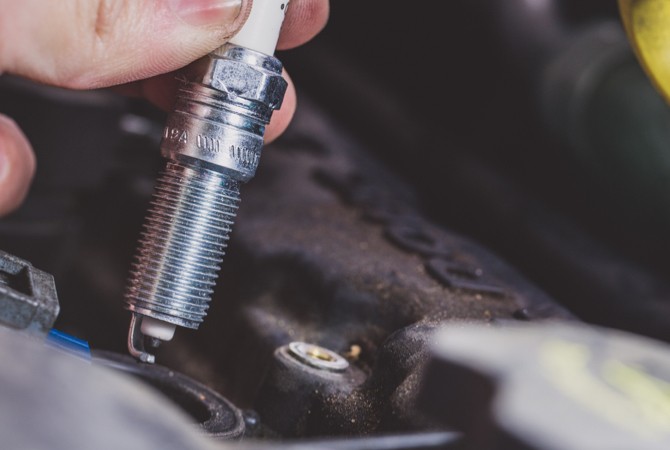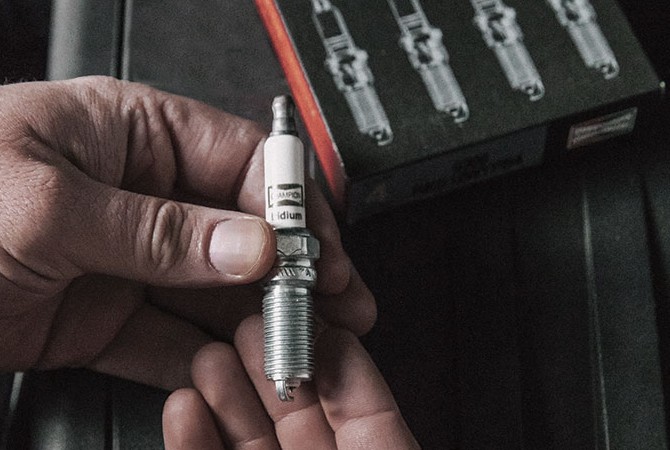Role of Spark Plugs
While the primary function of the spark plugs is providing the spark to ignite the air/fuel combination and start the engine, an equally important function of the engine’s spark plugs is to remove heat away from the combustion chamber. Spark plugs act as a heat exchanger, pulling thermal energy away from the combustion chamber and transferring it to the engine’s cooling system.

What is Spark Plug Heat Range?
A spark plug’s heat range is the degree to which it disperses heat. Spark plugs with high heat dispersal are referred to as cold, while plugs with less heat-dissipating characteristics are known as hot.
The structure of the spark plug affects the heat rating:
- Length of insulator nose
- Surface area
- Material of center electrode
- Position of the insulator tip
Hot Spark Plugs
Found in many passenger vehicles, hot spark plugs have more insulation to transfer the heat slowly, which keeps the temperature high enough to burn off carbon deposits and avoid premature fouling. This helps allow for more time between spark plug changes.
Characteristics of hot spark plugs:
- Longer insulator nose
- Transfers heat slowly
- Tip remains hot longer
- Burns off carbon deposits
Cold Spark Plugs
Cold spark plugs are good for high RPM engines and other situations where the engine operates at a high temperature. Because they transfer heat faster, cold spark plugs can get dirty and become fouled sooner because they don’t get hot enough to burn off carbon deposits.
Characteristics of cold spark plugs:
- Shorter insulator nose
- Transfers heat faster
- Tip remains cooler longer
Choosing the Right Spark Plug

Using the correct heat range is key to getting the performance you want out of your engine. For most vehicles, the manufacturer-recommended spark plug and heat range is the best option. Consult your owner’s manual for the right spark plug for your car.
However, for modified engines, you’ll need to select a spark plug based on the performance you want to achieve with your engine. Keep the following in mind:

If you use too cool of a spark plug that doesn’t heat up to the proper temperature, it won’t be able to burn off the carbon deposits, which can cause premature fouling. A fouled spark plug can lead to misfires and engine stalling.

Picking a spark plug with too hot of a heat range can result in overheating, causing electrodes to wear quickly, leading to pre-ignition and a reduction in fuel economy.
No matter what type of spark plug you are looking for, Champion® has a spark plug for your engine. Take a look at the chart for the range of Champion offerings. Please note that the numbers don’t indicate degrees; they’re product codes to give an indication of the heat range. The higher the number, the hotter the plug, and the lower the number, the colder the plug.
Automotive & Small Engine |
General & Industrial Engines |
High-Performance Engines |
23 |
|
|
21 |
|
|
20 |
|
|
19 |
95 |
|
|
92 |
|
18 |
91 |
|
17 |
90 |
|
16 |
|
|
15 |
|
|
14 |
|
|
13 |
|
|
12 |
86 |
|
11 |
|
|
10 |
|
|
9 |
|
|
8 |
|
|
7 |
|
|
6 |
85 |
63 |
5 |
82 |
61 |
4 |
81 |
59 |
|
79 |
|
|
78 |
|
3 |
77 |
57 |
|
76 |
|
|
75 |
|
2 |
|
55 |
1 |
|
54 |
|
|
53 |
Learn more about quality spark plugs, find your part, or find where to buy your part today.
The content contained in this article is for informational purposes only and should not be used in lieu of seeking professional advice from a certified technician or mechanic. We encourage you to consult with a certified technician or mechanic if you have specific questions or concerns relating to any of the topics covered herein. Under no circumstances will we be liable for any loss or damage caused by your reliance on any content.